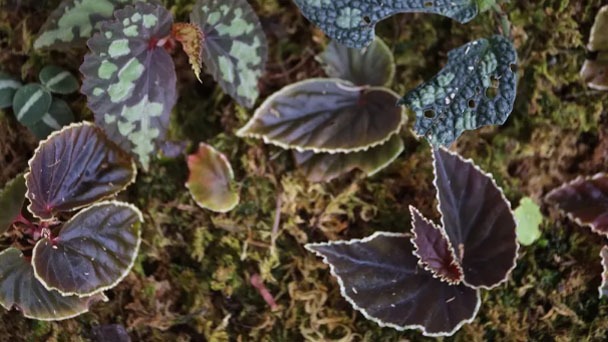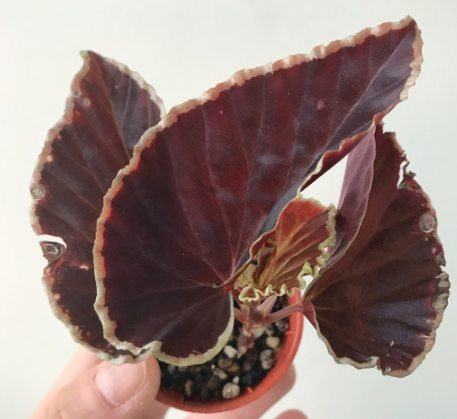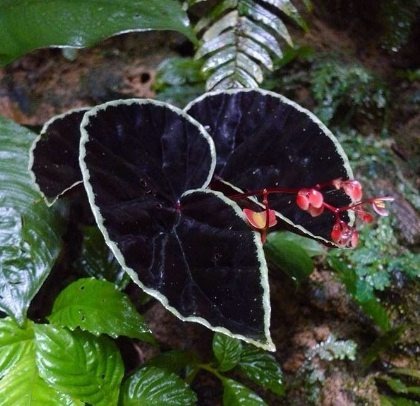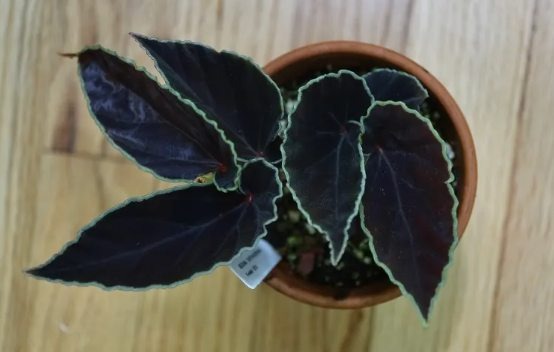How to Grow & Take Care of Begonia Darthvaderiana
Written by Ivy
Jan 05 2023

I'll describe how I take care of my Begonia darthvaderiana in this post. As a result of its high price and extreme sensitivity, it is undoubtedly not a plant for beginners. You will certainly enjoy watching this beauty grow, though, if you have any previous gardening experience.
Begonia Darthvaderiana Introduction
In 2014, the begonia species begonia darthvaderiana was found in Sarawak, an area of Borneo known for its variety of plants, particularly begonias. Begonia darthvaderiana is an extremely rare plant that thrives in its natural environment on cliffs in the dense shade of a rainforest.
Because of its undeniably striking appearance, including leaves that are so dark that they almost appear black and deep red flowers, Begonia darthvaderiana is also known as the Darth Vader Begonia. Begonia darthvaderiana's dark-colored leaves allow it to survive on the little sunlight that penetrates the dense rainforest canopy.

How to Take Care of Begonia Darthvaderiana
Soil
Begonia darthvaderiana potting mix must have excellent drainage. If the potting mix retains water, or the Begonia darthvaderiana is left stinging water, it will develp root rot very rapidly.
Most likely you will obtain a tiny Begonia darthvaderiana plug plant - layer the bottom of the pot with an inch of coarse perlite to protect roots from rotting. I advise layering pot with lecca for larger plants.
My Begonia darthvaderiana potting mix recipe is:
-
1 part peat moss
-
0.5 part perlite
-
0.5 part vermiculite
-
sprinkle of charcoal
-
sprinkle of shredded sphagnum moss
Light
As I mentioned earlier, Begonia darthvaderiana grows in low light in it's natural habitat. Like all begonias, exposure to the sun is strongly discouraged. While my Begonia darthvaderiana is dormant, It is in natural light and out of the sun. I employ grow lights once the growing season begins.
Humidity & Temperature
When I just got my Begonia darthvaderiana It was initially planted in my heated terrarium, which had a 27°C temperature and a 95% to 100% humidity level. It wasn't dying, so it must have been doing okay. Keeping it there to rest after traveling was probably a wise decision. However, when my Begonia darthvaderiana grew a new leaf, the older one melted away. (Read More: Do Begonia Plants Like Humidity?)
I figured it was too warm and too wet for her, so I moved my Begonia darthvaderiana to her own little glass dome and left it away from the heat mat, with humidity around 85%-90% and temperature 21C-23C degrees (it's the room temperature in my apartment).
Watering
Water Begonia darthvaderiana when soil is nearly dry, don't let it sit in water. Make sure water doesn't come in contact with the leaves. Begonia darthvaderiana can be very sensitive to chemicals in tap water - let the water sit in an open container for at least 48 hours before watering your Darth Vader's Begonia
Fertilizer
Begonia darthvaderiana responds well to fertilizing about once per month. Pick any organic, liquid fertilizer that contains nitrogen, and combine it with water. Winter is not the time to fertilize because the soil is already too weak. The Darth Vader plant needs fertilizer in the spring.
Repot
Repot Begonia darthvaderiana when the plant is root bound, it could be every year. Repotting is necessary if the roots start to protrude from the pot's base. In the absence of this, the plant will experience stress and its growth will be stifled.
Begonias do not like to be root-bound, in contrast to some other houseplants. Repotting your plants into a pot that is 1-2 sizes larger than their present pot is advised to keep them happy and healthy. This can be done either annually or every other year.
If you notice that your Begonia darthvaderiana plant's roots are poking out of the pot's drainage hole, it's time to repot.
If you don't mind the look, terra cotta pots can offer extra aeration that your plant will love. A drainage hole is a requirement when choosing a pot for your begonia.
When repotting your plant, exercise gentle handling. Begonia roots can be delicate, so just try your best to shake off the previous soil before planting it in the new pot.
Pruning
Darth Vader begonias don't really require any pruning; just get rid of any yellowing or lanky leaves, and you should be good to go.
However, you can prune your begonia as necessary if you want it to keep a particular shape. Avoid taking too many leaves at once, and after pruning, keep an eye on the health of your plant.
Growth
The height of the Begonia darthvaderiana plant can reach up to a foot and a half. They don't grow to be very large plants. However, they generate a lot of leaves.

Begonia Darthvaderiana Propagation
Propagating Begonia darthvaderiana can be done in three ways – root division, stem cuttings, and leaf cuttings.
1. Root Division
It's time to divide your Begonia darthvaderiana if the pot is full and there is no more room for it to grow. It will grow better if you divide the plant into two or more parts. To separate the roots and plant them in different pots, take the plant out of the pot and gently untangle them.
2. Stem Cuttings
Pick a stem, cut it below the node, take the cutting, and bury it in the soil mixture. The cutting may also be dipped in a rooting hormone (optional). Roots will start to appear in a few days. The cutting can also be kept in water to watch the roots grow over time. You can plant the cutting in soil once the roots are about 2 inches long. Compared to leaf cutting propagation, it is quicker.
3. Leaf Cuttings
It is also possible to reproduce from leaves. Do not give up if you see the plant's leaves melting; instead, take a healthy leaf and propagate it. Pick a leaf that appears healthy, then cover it with a rooting hormone before planting it. Roots will start to appear in five weeks.
Common Problems
Fungi and Root Rot
Begonia darthvaderiana is prone to fungi and root rot. Once the fungus has taken over the plant, it can be challenging to completely eradicate it. As a result, we cautioned against over-watering and excessive bare-hand contact with the leaves.
Pests and Insects
Pests and insects like spider mites can infest Begonia darthvaderiana. Spraying neem oil on the leaves and gently wiping it off with a soft cloth or tissue is the best and most efficient way to get rid of these pests.
Yellowing of Leaves
Begonia darthvaderiana also frequently experiences issues with its leaves turning yellow. Overwatering is frequently indicated by the yellowing of the leaves. Overwatering prevents oxygen from getting to the roots, which eventually causes root rot.
Always stick your finger inside the soil to prevent overwatering your plant. It's time to water if the test results are dry. To prevent overwatering, you can also use the bottom watering technique. (Read More: Why Does My Begonia Leaves Turning Yellow)
Melting Leaves
The leaves of Begonia darthvaderiana start to deteriorate whenever the temperature exceeds 80–82 degrees Fahrenheit. Move your plant to a cooler, more shaded location that doesn't get a lot of hot air if you notice this is happening to it.
White Spots on Leaves
If kept in a sunny location, Begonia darthvaderiana's leaves are prone to burning. Therefore, you will see white spots on the leaves before they begin to melt. This is a sign that the temperature is becoming unbearable for the plant. Moving it to a cooler location is necessary before the leaves completely wilt.

Other Varieties of Begonias
Beautiful plants, begonias are. The most lovely flowers and leaves are produced by them. And the Begonia darthvaderiana plant is just one of many.
Here are a few of our favorite Begonia species:
- Begonia boliviensis
The begonia boliviensis plant makes us think of the holiday. Gorgeous red flowers and sharp, dark green leaves are produced by this plant.
- Begonia reiger
Our favorite begonia is this one. It makes any space more beautiful. The flowers have edges that are pink with a pale yellow center.
- Begonia rex
Leaves are absent on this Begonia rex. But it does produce the most beautiful spiky leaves. These leaves have a cool green edge and a pink interior.
Conclusion
Begonia darthvaderiana attracts attention with its exquisite black foliage.
The plant Begonia darthvaderiana is distinct. There are no other plants like this one. Even Begonia species like this unique one don't exist. That this beauty was only discovered so recently is regrettable.
One of these plants requires some thought when caring for it. However, the process is straightforward and worth every second of effort. You can have a blooming Begonia in your home if you keep an eye out and have a positive attitude.
FAQs
How Long Does It Take for the Begonia Darthvaderiana to Start to Sprout?
Begonia darthvaderiana plants start to sprout in about four to six weeks. However, it might take more time if your Begonia is in a cold environment.
Is Begonia Darthvaderiana Rare?
One of the most uncommon begonias is Begonia darthvaderiana. Although it was only discovered in 2014 and is therefore a relatively new addition to the hobby, it is fairly simple to maintain and grow. This indicates that as more growers are able to use it, it will probably become more widely accessible in the future.
Why Do Begonia Leaves Melt?
Overwatering is the primary reason why begonia leaves start to melt. Even though they do require a lot of water, these plants are more prone to root rot and melt than most other houseplants. You might need to remove your plant from its pot, examine its roots, remove any blackened or dead roots, and then repot it in fresh soil if your plant's leaves are suffering.
Is Begonia Darthvaderiana Hard to Care For?
It is not too difficult to care for the Darth Vader Begonia. I wouldn't recommend it for a beginner in the hobby because of the cost, but if you've successfully kept a few other begonias, you can probably handle this rare beauty.
Can I Use a Terrarium for the Begonia Darthvaderiana?
The Begonia darthvaderiana plant is suitable for terrarium use. A terrarium is typically preferred over a plant pot. When it comes to this unique plant, it's what you feel comfortable with. However, terrariums do make the process simpler.
How Can I Get My Begonia Darthvaderiana to Bloom More Often?
Make sure your Begonia darthvaderiana receives plenty of indirect sunlight if you want it to bloom more. In order to prevent saturation, the soil should always be moist. Consider reducing the amount of fertilizer you give it. When overfertilized, it may experience stunted growth and a slowed blooming cycle. It was caused by burning fertilizer.
Latest Updated
- Benefits of Bugleweed - 7 Science-backed Health Benefits
- Bugleweed Dangers & Side Effects - Is It Poisonous?
- How to Plant Evergreen Trees - What You Should Know
- When to Plant Evergreens - Grow Guide for Evergreen Trees
- 12 Wonderful Evergreen Shrubs for Your Garden
- 12 Popular Evergreen Plants with Pictures for Beginners
- When And How To Prune A Lilac Bush Like a Pro
- How to Grow & Care for Lilac Vine (Hardenbergia Violacea)
- Japanese Lilac Tree (Syringa Reticulata) Care & Propagation Guide
- Shumard Oak Pros and Cons - What to Know
Popular Articles
- Winter maintenance of Antirrhinum Majus
- How to Grow Terminalia Mantaly Tree
- How to Grow and Care for Crossostephium Chinense
- How to grow Antirrhinum Majus in spring
- Peristeria Elata (Dove Orchid) Profile: Info & Care Guide
- Underwatered Snake Plant (Sansevieria Trifasciata) - Signs And How To Fix
- How to Care for Brazilian Jasmine Plant (Mandevilla Sanderi)
- How to Grow & Care for Graptopetalum Purple Delight in Summer
- Rosa Chinensis (China Rose): Plant Growing & Care Tips
- How to Care for Baby Sun Rose (Aptenia Cordifolia)